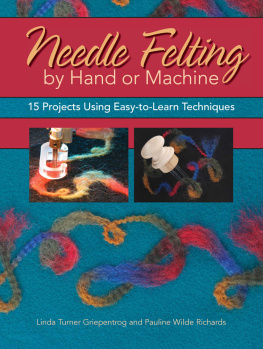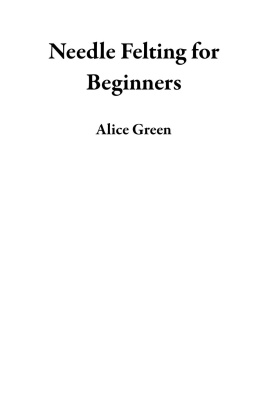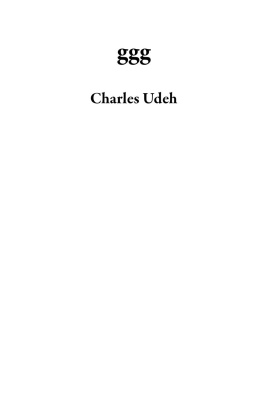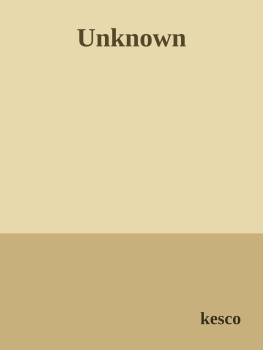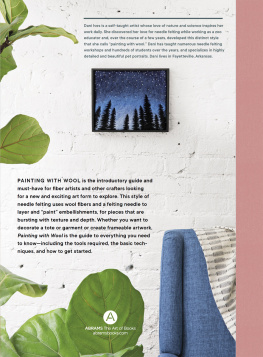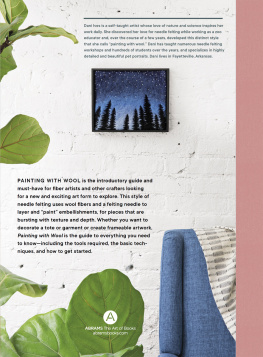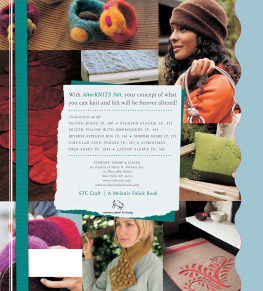Needle Felting
by Hand or Machine

Linda Turner Griepentrog and Pauline Wilde Richards
2007 Linda Turner Griepentrog and Pauline Wilde Richards
Published by

Our toll-free number to place an order or obtain a free catalog is (800) 258-0929.
All rights reserved. No portion of this publication may be reproduced or transmitted in any form or by any means, electronic or mechanical, including photocopy, recording, or any information storage and retrieval system, without permission in writing from the publisher, except by a reviewer who may quote brief passages in a critical article or review to be printed in a magazine or newspaper, or electronically transmitted on radio, television, or the Internet.
The following registered trademark terms and companies appear in this publication: Angelina, Aunt Martha's Iron-on Transfers, Baby Lock, Beacon Adhesives, Bernina, Brother, Bubblewrap, Caron, Clover Needlecraft, Coats & Clark, Colonial Needle, Colonial Patterns, Crafter's Pick, Dancing Needleworks, Disney, DMC, Embellisher, Fab Felter, Fabri-Solvy, Fabri-Tac, Fanatica Fibers, Feltcrafts, Fusible Warm Fleece, Husqvarna Viking, Jacquard Products, Janome, June Tailor, Kandi Corp., Kandi Kane, Klaer International, KK2000, Lion Brand Yarns, Lumiere, MacPhee Workshop, Mickey Mouse, Mix'n Match Templates for Quilters, My Favorite Thimble, Mylar, National Nonwovens, Plaid, Poly-Fil, Red Heart, Sewing with Nancy, ShadedWisps, Simply Stencils, Soy Silk, Steam-A-Seam2, Stitch N Shape, Sulky of America, Swarovski, Tear-Easy, The Ultimate! Glue, The Warm Company, Ultra-Fine Threader, Warm & Natural, WizPick, Woolcombs WoolWisps, WoolFelt, Xpression
Library of Congress Catalog Number: 2006935659
ISBN: 978-0-89689-485-3
eISBN 13: 978-1-4402-2108-8
Designed by Heidi Bittner-Zastrow
Edited by Tracy L. Conradt
Printed in United States of America
Cover photos
Machine: Courtesy of Bernina of America, Inc.
Felting tool: Courtesy of My Favorite Thimble
acknowledgments
We would like to thank several people for their help with this book, not only in providing products for us to use, but also for providing inspiration and sharing their own fiber creations for us to share with you. Look for the names of talent fiber artists throughout the text and the gallery sections.
Special thanks go to Janet Klaer, who sent us a large box of fabric from her well-organized stash, so that we could felt it up for projects in the book. Keep in mind that we also had lots of fabric of our own, but the grass is always greener elsewhere, and that's true with fabrics as well.
Kudos to artist Missy Shepler for drawing our how-tos. Because she's a sewer and fiber artist herself, she has understanding of what she's trying to communicate through her illustrations, making it easier for you to visualize the project steps.
Thanks go as well to our industry friends who supplied us with ideas and contacts of notable felters so that we could share their work with you.
And many thanks to our husbands, Keith and John, who put up with our fabric and fiber madness on a daily basis we love what we do and appreciate their support.
Introduction
W ho would have thought I'd be writing about needle felting? I've always shied away from anything related to handwork, and zealously pursued challenging the sewing machine with unusual tasks. I'd always opt to do anything by machine that I could.
Then, one day I was introduced to the Baby Lock Embellisher, a machine dedicated to felting. An astute salesperson was armed with some wonderful woolly samples that got me hooked on the potential. After all, I love anything related to fibers and fabric.
As a weaver many years ago, the lure of fabulous fibers was simmering again and the creative potential with this specialty machine seemed unrivaled.
I was hooked, and began researching the topic, only to find other machine options available, and a huge following of those who needle felt by hand, doing some things not possible by machine. Hmmm sign me up and let me at the tools and fibers. I started wondering, as I often do, I wonder if you could You will find the answers to many of those speculations in this book, as most visions I had for creative options worked out.
My good friend, and now co-author, Pauline Richards immediately took to the machine as well and was equally leery of the hand option, but lo and behold, she now loves it, too. It seems each method has its purpose. Both of us have been strong advocates for machine work in our sewing writing careers, but as we've discovered with needle felting, handwork does have its place.
Our approach to needle felting is that it's great fun and that's what should be explored. We have included some technical information in the book as well, just so you know the facts about what could easily become your latest creative addiction.
So, join us in this wonderful, woolly adventure and felt your heart out creating some easy-to-learn projects we've developed to help you explore a variety of techniques. Grab the fibers, and let the barbs begin (on the needles, that is).
~ Linda
T here's something very soothing about working with fabric, fibers or yarns and for me, needle felting by hand or machine is wonderful therapy because it brings these three elements together in a unique way. Needle felting has opened a new avenue for self-expression.
I always enjoy visiting fabric or yarn shops even when I don't have a project in mind. I love to look for inspiration and enjoy spending time feeling the fibers. Needle felting allows me to build, layer, coax, combine and create using all parts of my abundant fiber stash.
What could be better than co-authoring a book on a technique I love, with my friend and mentor, Linda Griepentrog. Together we see unending possibilities to combine needle felting with many other creative techniques. This book is just the beginning of our ideas and it's a privilege to share our creative journey with you.
Let the felting begin!
Pauline
Warning!
Needle felting can be very addicting,
so plan storage space for the fibers,
fabrics and tools you'll accumulate.
CHAPTER 1
What's all the fuzz about?
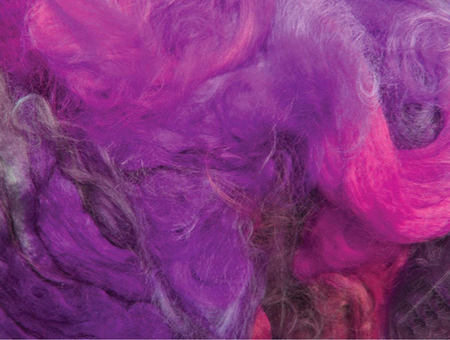
Conjoined Creations Soy Silk photo
There's a buzz about needle felting that creative people can't ignore. Colorful, fuzzy fibers lure us into the have-to-do-it mode, but how did it all start?
A Bit of History
We can probably blame the first remnants (no pun intended) of felting on the cavemen who used sheepskins to protect their bodies and feet from the weather. Add in precipitation and the friction of walking around in the wild in their daily pursuit of prey, and you have the first stages of the felting frenzy.
Felt can be created by two processes: dry felting and wet felting, and our cavemen utilized the second for their wardrobing.
When water is added to wool fiber, it raises the scales. When accompanied by friction and heat, the fibers interlock to form a dense mass and felting results. In the case of our early ancestors, the felting process was likely accidental. As they stomped around in the wild and laundered their clothes on wet stones, fibers of their wooly body coverings matted and shrunk, creating primitive felt.

